#fuel api
Explore tagged Tumblr posts
Text
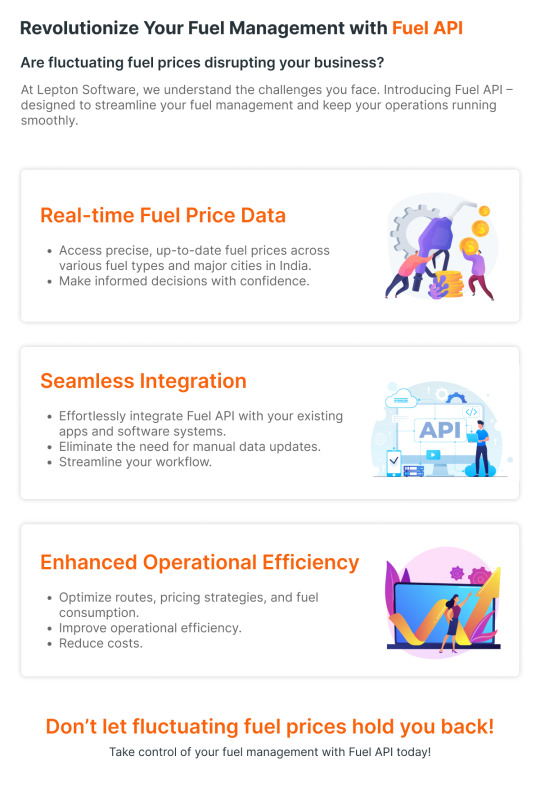
Revolutionize your Fuel Management with Lepton Maps Fuel API
Get Real-Time Fuel Price, Seamless Integration, Enhanced Operational Efficiency and Accurate Data. Click to learn more: https://leptonmaps.com/docs/nearby/fueling_stations
#lepton maps#lepton maps apis#map apis#fuel api#fuel apis#fue station data#real time data#geospatial data#datasets
0 notes
Text
How Distance Matrix API Facilitates Route Optimization
In this digital era, efficient logistics and route planning have become vital for businesses and individuals alike. One of the many tools that have made this possible is the Distance Matrix API. This tool is instrumental in optimizing routes, saving time, reducing fuel consumption, and facilitating dynamic updates for real-time route changes. This article will explore how the distance api…
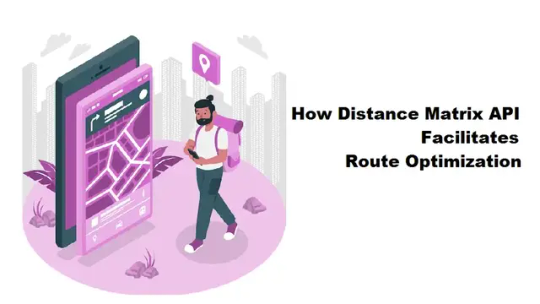
View On WordPress
#Algorithms Behind Route Optimization#Distance API#Distance matrix API#Reducing Fuel Consumption#Route Optimization
0 notes
Text
<body>

<h1> computer id pack </h1>

<div class="names">
<p> cyber , tech , pixel , digital , quantum , hp , code , script , binary , html , ip , al , nano , virus , malware , glitch , byte , cache , chip , chrome , error , spark , static , monitor , password </p>
</div>

<div class="pronouns">
<p> key / board , ai / ais , 404 / 404s , code / codes , html / htmls , java / script , py / thon , url / urls , web / webs , api / apis , inter / net , pix / pixel , .png / .pngs , .gif / .gifs , .rar / .rars , .zip / .zips , .txt / .txts , mal / ware , desktop / desktops , software / softwares , hardware / hardwares , password / passwords </p>
</div>

<div class="titles">
<p> the coded one , the digital one , the electronic one , the computer , the program , the programmer , prn who is made of binary , prn who is made of code , prn who codes , prn who is a computer , prn who is digital , the ai , the sentient ai , the sentient computer , prns wires , prn who is made of wires , the error , the virus , the website </p>
</div>

<p> requested by : nobody </p>
<p> self indulgent id pack to fuel my computerkin identity. feel free to use anything listed here. </p>

</body>
#⟡ webtiles#⟡ npt request#npt pack#npt list#npt ideas#id pack#id list#id ideas#computer#tech#internet
26 notes
·
View notes
Text
2024 team sponsors recap!
this is completely irrelevant to F1 but i study and do these stuffs for a living sooo 😩😩 2023 sponsors are based on the sponsors that are there at the beginning of the season (new sponsors that join in the middle of the season will be classified as 2024's)
Mercedes AMG Petronas F1 Team:
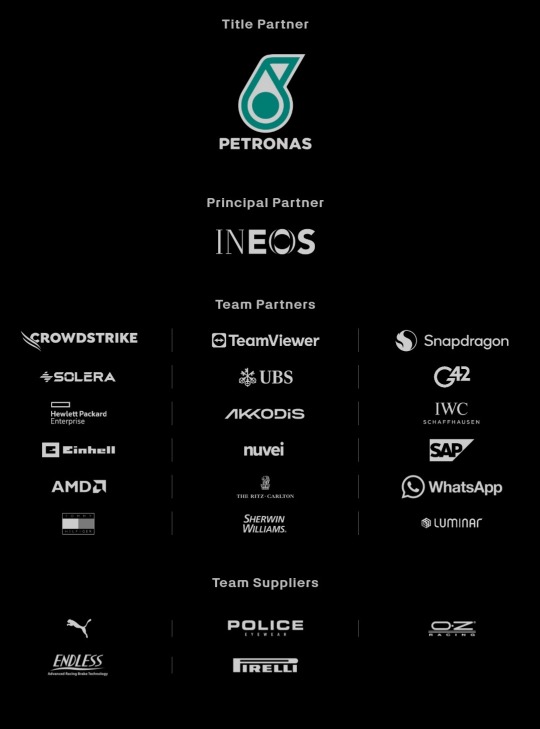
New sponsors: Whatsapp, Luminar (American tech company), SAP (German software company), nuvei (Canadian credit card services), Sherwin Williams (American painting company) 2024 data last update: 2024/02/14
Old sponsors that left: Monster Energy, Pure Storage (American technology company), fastly (American cloud computing services), Axalta (American painting company), Eight sleep (American mattresses company) 2023 data last update: 2023/01/07
Oracle Red Bull Racing F1 Team:
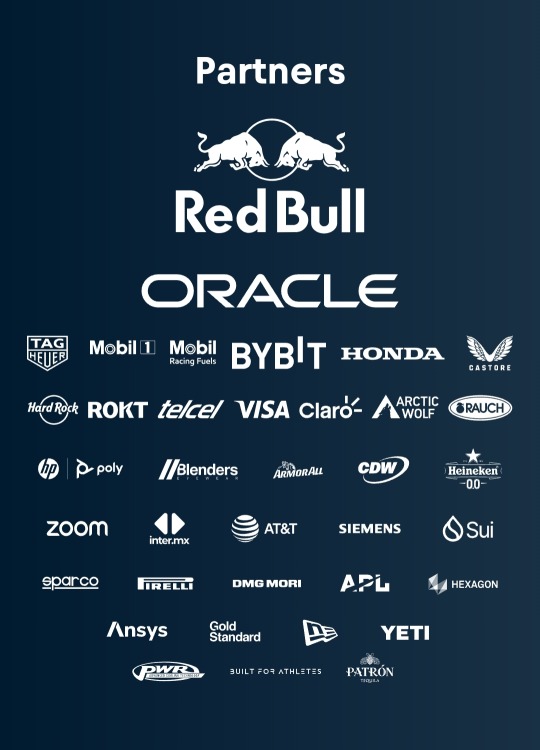
New sponsors: Yeti (American cooler manufacturer, joined later in 2023), APL (American footwear/athletic apparel manufacturer, joined later in 2023), CDW (American IT company, joined later in 2023), Sui (American tech app by Mysten Labs, joined later in 2023), Patron Tequila (Mexican alcoholic beverages company, joined later in 2023) 2024 data last update: 2024/02/15
Old sponsors that left: CashApp, Walmart, Therabody (American wellness technology company), Ocean Bottle (Norwegian reusable bottle manufacturer), PokerStars (Costa Rican gambling site), Alpha Tauri (? no info if they're official partners or not but Austrian clothing company made by Red Bull), BMC (Switzerland bicycle/cycling manufacturer), Esso (American fuel company, subsidiary of ExxonMobil), Hewlett Packard Enterprise (American technology company) 2023 data last update: 2023/03/07
More: Esso is a subsidiary of Mobil so there's possibility they merged or something
Scuderia Ferrari:

New sponsors: VGW Play (Australian tech game company, joined later in 2023), DXC Technology (American IT company, joined later in 2023), Peroni (Italian brewing company), Z Capital Group/ZCG (American private asset management/merchant bank company), Celsius (Swedish energy drink manufacturer) 2024 data last update: 2024/02/15
Old sponsors that left: Mission Winnow (American content lab by Phillip Morris International aka Marlboro), Estrella Garcia (Spanish alcoholic beverages manufacturer), Frecciarossa (Italian high speed train company) 2023 data last update: 2023/02/16
More: Mission Winnow is a part of Phillip Morris International. They are no longer listed as team sponsor but PMI is listed instead.
(starting here, 2023 data last update is 2023/02/23 and 2024 data last update is 2024/02/15)
McLaren F1 Team: (Only McLaren RACING's data is available idk if some of these are XE/FE team partners but anw..)
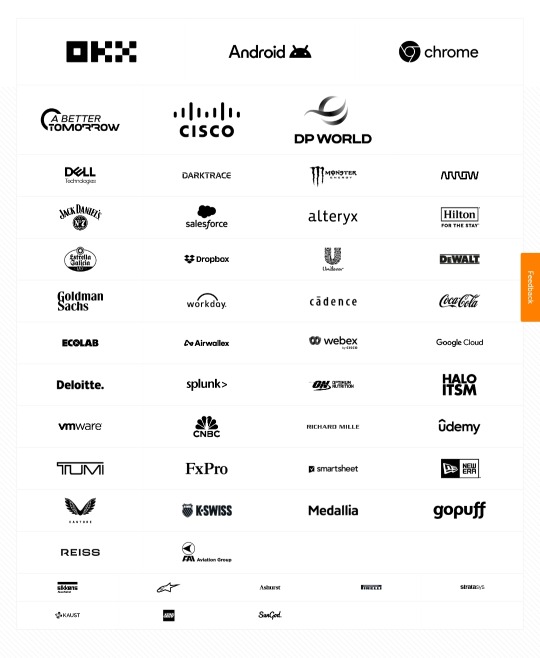
New sponsors: Monster Energy, Salesforce (American cloud based software company, joined later in 2023), Estrella Garcia (Spanish alcoholic beverages manufacturer), Dropbox (American file hosting company), Workday (American system software company, joined later in 2023), Ecolab (American water purification/hygiene company), Airwallex (Australian financial tech company), Optimum Nutrition (American nutritional supplement manufacturer), Halo ITSM (American software company, joined later in 2023), Udemy (American educational tech company, joined later in 2023), New Era (American cap manufacturer, joined in 2023), K-Swiss (American shoes manufacturer, joined later in 2023), Alpinestars (Italian motorsports safety equipment manufacturer)
Old sponsors that left: DP World (Emirati logistics company), EasyPost (American shipping API company), Immersive Labs (UK cybersecurity training company?), Logitech, Mind (UK mental health charity), PartyCasino (UK? online casino site), PartyPoker (American? gambling site), Sparco (Italian auto part & accessory manufacturer), Tezos (Switzerland crypto company)
Aston Martin Aramco F1 Team:

New sponsors: Valvoline (American retail automotives service company, joined later in 2023), NexGen (Canadian sustainable? fuel company), Banco Master (Brazilian digital banking platform, joined later in 2023), ServiceNow (American software company, joined later in 2023), Regent Seven Seas Cruise, Wolfgang Puck (Austrian-American chef and restaurant owner, joined later in 2023), Financial Times (British business newspaper), OMP (Italian racing safety equipment manufacturer), stichd (Netherlands fashion & apparel manufacturer)
Old sponsors that left: Alpinestars (Italian motorsports safety equipment manufacturer), crypto.com (Singaporean cryptocurrency company), ebb3 (UK? software company), Pelmark (UK fashion and apparel manufacturer), Peroni (Italian brewing company), Porto Seguro (Brazilian insurance company), Socios (Malta's blockchain-based platform), XP (Brazilian investment company)
Stake F1 Team (prev. Alfa Romeo):
???? Can't found their website (might be geoblocked in my country???)
BWT Alpine F1 Team:

New sponsors: MNTN (American software company), H. Moser & Cie (Switzerland watch manufacturer), Amazon Music
Old sponsors that left: Bell & Ross (French watch company), Ecowatt (??? afaik French less-energy smthn smthn company), Elysium (French? American? Software company), KX (UK software company), Plug (American electrical equipment manufacturing company)
Visa CashApp RB F1 Team (prev. Scuderia Alpha Tauri):

New Sponsors: Visa, CashApp, Hugo Boss, Tudor, Neft Vodka (Austrian alcoholic beverages company), Piquadro (Italian luxury bag manufacturer)
Old sponsors that left: Buzz (?), Carl Friedrik (UK travel goods manufacturer), Flex Box (Hongkong? shipping containers manufacturer), GMG (Emirati global wellbeing company), RapidAPI (American API company)
Haas F1 Team:

New sponsors: New Era (American cap manufacturer, joined later in 2023)
Old sponsors that left: Hantec Markets (Hongkong capital markets company), OpenSea (American NFT/Crypto company)
Williams Racing:


New sponsors: Komatsu, MyProtein (British bodybuilding supplement), Kraken (American crypto company, joined later in 2023), VAST Data (American tech company), Ingenuity Commerce (UK e-commerce platform), Puma (joined later in 2023)
Old sponsors that left: Acronis (Swiss software company), Bremont (British watch manufacturer), Dtex Systems (American? cybersecurity company), Financial Times (British business newspaper), Jumeirah Hotels & Resorts, KX (UK software company), OMP (Italian racing safety equipment manufacturer), PPG (American painting manufacturer), Umbro (English sports equipment manufacturer), Zeiss (German opticals/optometrics manufacturing company)
#mercedes amg petronas#red bull racing#scuderia ferrari#visa cash app rb#haas f1 team#mclaren f1#aston martin#alpine f1#williams racing#stake f1 team#f1#ari's rant#sponsor talks
42 notes
·
View notes
Text
The Nation-State of California, the world’s fifth or sixth largest economy (depending on who’s talking and what week it is), is suing some of the biggest players in the oil industry for damages caused by climate change, arguing that Big Oil knew for decades that burning fossil fuels would have catastrophic effects on the planet’s climate, but that the industry conducted a “decades-long campaign of deception” to protect its profits, causing tens of billions of damage in California alone. This could be HUGE.
California Attorney General Rob Bonta filed the suit Friday in state court in Sacramento, against oil giants Exxon Mobil, Shell, Chevron (which is headquartered in California), ConocoPhillips, and the oil industry trade group, the American Petroleum Institute (API), that oily hive of scum and villainy.
94 notes
·
View notes
Text
Excerpt from this story from the Union of Concerned Scientists:
The U.S. oil and gas industry has sounded its mating call to the incoming Presidential administration with a policy wish list remarkable for its unabated pursuit of profits and defiance of climate science and economic trends.
The American Petroleum Institute (API) released a “policy roadmap” addressed to President-elect Donald Trump on November 12 outlining five “actions” he can take to bolster their agenda. However, the “actions”—given euphemistic titles like “protect consumer choice”—actually aim to roll back science-based environmental protections in order to maximize already massive profits. The policy details within each action roughly correspond with recommendations in Project 2025, the infamous policy agenda penned in part by figures from the first Trump administration and supported by several anti-climate organizations.
Here’s a breakdown of the roadmap’s requests along with an explanation of how they would roll back environmental progress.
API’s anti-environment entreaties
Fight clean cars. API’s first policy proposal is repealing rules designed to support the shift to electric vehicles that the oil and gas industry has fought for decades. API specifically targets Environmental Protection Agency (EPA) rules to reduce carbon emissions from automobile tailpipes and fuel economy standards established by the National Highway Traffic Safety Administration. API also targets an EPA waiver for a 2022 California rule that would reduce pollution from new gasoline-powered cars while increasing sales requirements for zero-emission vehicles.
Pump up gas. The second policy proposal is to reinstate permitting of liquified natural gas (LNG), also known as methane, a fossil fuel that is a potent source of global warming emissions. The Biden administration temporarily paused pending approvals for new LNG export authorizations in January 2024, citing the need to update the review process to best reflect impacts on climate, domestic energy prices, and health—especially as borne by frontline communities.
Reverse protections for public land and health. The third policy proposal focuses on federal lands that API believes should be opened up to drilling, both onshore and offshore. It recommends repealing a Bureau of Land Management rule that would put conservation on equal footing with drilling and ranching as a legal use of public lands, in addition to adding more leasing opportunities from the Bureau of Ocean Energy Management’s offshore leasing program. But the most blatantly anti-climate demand in this area would repeal a Congressionally approved fee on every metric ton of methane that high-emitting oil and gas facilities produce above specific levels. The oil and gas industry is responsible for 30 percent of human-caused methane emissions.
Muzzle environmental reviews. The fourth policy proposal involves the federal permitting process, a perennial enemy of the fossil fuel industry. The statute in their crosshairs is the National Environmental Protection Act (NEPA), which the industry has fought since it was signed into law by Republican President Richard Nixon in the 1970s. API and Project 2025 sing from the same sheet in their NEPA-related demands, which would curtail scientific and environmental reviews, limit public notice and comment, and block access to the courts.
Preserve industry giveaways. API finishes off its wish list with requests to preserve fossil fuel industry tax breaks that cost taxpayers some $3 billion each year, regardless of how much they’re currently paying at the pump.
6 notes
·
View notes
Text
🚀 The Ultimate Guide to Random Generators: Tools, Tricks & Creative Uses 🎲
From sparking creativity to solving coding problems, random generators are the unsung heroes of the digital world. Whether you need words, names, colors, or even RPG characters, there’s a tool for it.
5 Types of Random Generators You Need
1️⃣ Random Word Generators (For Writers & Brainstorming)
Use Case: Beat writer’s block, create poetry, or name characters.
Example Tools:
Random Words Generate (Simple & fast)
WordGenerator.net (Advanced filters)
2️⃣ Name Generators (For Gamers & Authors)
Need a fantasy villain name or startup business idea? These tools help:
Fantasy Name Generators
Behind the Name
3️⃣ Color Palette Generators (For Designers)
Cool Tools:
Coolors.co (Instant palettes)
Adobe Color (Advanced schemes)
4️⃣ Random Number Generators (For Devs & Gamers)
Best Picks:
Random.org (True randomness)
Calculator.net’s RNG
5️⃣ Meme & Fun Generators (For Social Media)
Try:
ImgFlip Meme Generator
This Person Does Not Exist (AI faces!)
💡 Pro Tips for Using Random Generators
✔ Writers: Mix 3 random words into a story plot. (Example: "A robot, banana, and black hole walk into a bar…") ✔ Developers: Use random data for testing APIs. ✔ Designers: Generate color combos for logos.
🔗 Why Bookmark These Tools?
100% Free – No hidden payments.
No Login Needed – Instant results.
Creative Fuel – Endless ideas in seconds.
📌 Try Now: RandomWordsGenerate.com
#randomwords#online tools#word generator#writers#writingtips#creativity#randomwordsgenerate#tumber#tumblrwriters
3 notes
·
View notes
Text
Oil interests have funded cultural institutions such as museums, youth organizations and athletic groups in recent years, new research shows, in what appears to be a public relations effort to boost their image amid growing public awareness of the climate crisis.
Top US fossil fuel lobby group the American Petroleum Institute (API) sponsored a 2017 workshop for the Pennsylvania Girl Scouts, featuring “activities that mimicked work in the energy industry”. Energy giant BP in 2016 sponsored Washington DC’s National Gallery of Art and continues to fund the British Museum in London.
The new evidence of sponsorships was found in internal communications from 2015 to 2021 subpoenaed from big oil via a US congressional investigation last year. They were uncovered by Rebecca John, a researcher at the Climate Investigations Center, and published in the climate outlet DeSmog.
The documents also shed light on the particular value the companies see in the partnerships. In a 2017 email, for instance, the then CEO of API said the Girl Scouts sponsorship came as part of an effort to partner with “nontraditional local allies”, which he described as “some of the best and most influential voices with targeted policymakers on industry issues” who can help the lobby group overcome “policy issues”. API has a large lobbying presence in Pennsylvania, which is the country’s second-largest gas producer.
The British Museum has previously defended its partnership with BP, including after the company scaled back its climate goals this past February. The museum needs “corporate and private donations from companies like BP to ensure that the magnificent collection stays on display to the public for centuries to come”, a spokesperson told the Guardian at the time.
The documents indicate that in Shell’s 2020 “reputation plan” it said it would “secure partnerships with credible external influencers” in an effort to overcome “low credibility and trust” in the company.
The oil giant has partnered with a wide variety of major museums, sporting events, concert halls and other arts and cultural institutions. It could not be reached for comment, but its spokespeople previously said institutions can maintain their freedom even as they receive funding from Shell.
A 2017 internal memo from BP America says the relationships could provide a shield from “threats to BP’s reputation”, including “overall negative sentiment about the oil and gas industry” and the “policy and politics of climate change”. A separate 2016 document assessing the company’s “position” instructed staff to emphasize the message that more than 50 million people in the UK had “engaged with a BP-supported activity” due to its funding of institutions such as the British Museum and Royal Shakespeare Company.
The revelations come as activists have increasingly pressured arts and cultural institutions to cut ties with fossil fuel interests. The Royal Shakespeare Company, for instance, ended its BP partnership in 2019 after eight years, following months of protests over the partnership. At the time, BP said it was “disappointed and dismayed” by the decision.
DeSmog found evidence of dozens of other cultural sponsorships from the energy companies between 2015 and 2021, including of libraries, music festivals, gender justice initiatives and theaters. There have been hundreds of similar partnerships through history, from a children’s radio show funded by Standard Oil in the 1930s, to the current sponsorship of a media podcast by BP.
The relationships illustrate a decades-long industry strategy known as “affinity of purpose advertising”, said Robert Brulle, an environmental sociologist at Brown University. The term was coined by Herbert Schmertz, the late executive of Mobil Oil (now ExxonMobil).
“It’s the idea that if a corporation is associated with a high-value, cultural activity that prestige rubs off on the corporation,” said Brulle. In one well-known historical example, Mobil in the 1970s began sponsoring the television drama series Masterpiece Theater.
“Apparently this works quite well,” said Brulle, noting that Mobil evaluated the approach in a 1980 study and decided it was worthwhile. “It [has] now become a commonplace activity to burnish their corporate reputation and goodwill by sponsoring these types of cultural activities.”
2 notes
·
View notes
Text
Out of all the Keepers the South-West Deity has possessed, the closest It got to Its true form in terms of emotions and personality is Agni.
Once upon a time, the South-West Deity was a kind Pokemon; It didn't mind helping out the Humans in Its area so long as they said thank you and...be polite. Be grateful. Be kind to each other. It stoked the fires of life, inspiring the motto of the Sugiriyasa family. It provided warmth, fuel, and kindness above all...
And then eventually, the Humans took advantage of the South-West Deity. Slowly but surely, It resented the Humans. It didn't want to kill Humankind, but there's a burning in Its heart in their talons in their feathers whenever a foul word about them hits Its ears. It kept a cheerful demeanor, no one but the other Companions can tell this...change in It. But oblivious to the South-West Deity: all the Companions are changing.
One day, the Companions fell apart: the North and South-West fought a harsh battle that nearly killed the pair--everyone was splintering off into their own paths. Its heart broke, crying and crying and losing Its flame to help the Humans and helping the Sugiriyasa family. That sadness eventually made way for anger and the volcano? The temple was nearly destroyed.
Eventually Its body was lost to time, only living as a spirit inhabiting the Gym Leaders of Api City.
But somehow, It resonated the most with Agni. And It will do anything to make sure they live as long as they can.
#iknewit.mp3 (ooc)#headcanon#drabbles#((i cant be asked to fish for these tags))#but yeah hi more lore#Agni is truly the S-W Deity's favorite lmao#((probably wont make sense but gurgles))
2 notes
·
View notes
Text
Why Python Will Thrive: Future Trends and Applications
Python has already made a significant impact in the tech world, and its trajectory for the future is even more promising. From its simplicity and versatility to its widespread use in cutting-edge technologies, Python is expected to continue thriving in the coming years. Considering the kind support of Python Course in Chennai Whatever your level of experience or reason for switching from another programming language, learning Python gets much more fun.

Let's explore why Python will remain at the forefront of software development and what trends and applications will contribute to its ongoing dominance.
1. Artificial Intelligence and Machine Learning
Python is already the go-to language for AI and machine learning, and its role in these fields is set to expand further. With powerful libraries such as TensorFlow, PyTorch, and Scikit-learn, Python simplifies the development of machine learning models and artificial intelligence applications. As more industries integrate AI for automation, personalization, and predictive analytics, Python will remain a core language for developing intelligent systems.
2. Data Science and Big Data
Data science is one of the most significant areas where Python has excelled. Libraries like Pandas, NumPy, and Matplotlib make data manipulation and visualization simple and efficient. As companies and organizations continue to generate and analyze vast amounts of data, Python’s ability to process, clean, and visualize big data will only become more critical. Additionally, Python’s compatibility with big data platforms like Hadoop and Apache Spark ensures that it will remain a major player in data-driven decision-making.
3. Web Development
Python’s role in web development is growing thanks to frameworks like Django and Flask, which provide robust, scalable, and secure solutions for building web applications. With the increasing demand for interactive websites and APIs, Python is well-positioned to continue serving as a top language for backend development. Its integration with cloud computing platforms will also fuel its growth in building modern web applications that scale efficiently.
4. Automation and Scripting
Automation is another area where Python excels. Developers use Python to automate tasks ranging from system administration to testing and deployment. With the rise of DevOps practices and the growing demand for workflow automation, Python’s role in streamlining repetitive processes will continue to grow. Businesses across industries will rely on Python to boost productivity, reduce errors, and optimize performance. With the aid of Best Online Training & Placement Programs, which offer comprehensive training and job placement support to anyone looking to develop their talents, it’s easier to learn this tool and advance your career.

5. Cybersecurity and Ethical Hacking
With cyber threats becoming increasingly sophisticated, cybersecurity is a critical concern for businesses worldwide. Python is widely used for penetration testing, vulnerability scanning, and threat detection due to its simplicity and effectiveness. Libraries like Scapy and PyCrypto make Python an excellent choice for ethical hacking and security professionals. As the need for robust cybersecurity measures increases, Python’s role in safeguarding digital assets will continue to thrive.
6. Internet of Things (IoT)
Python’s compatibility with microcontrollers and embedded systems makes it a strong contender in the growing field of IoT. Frameworks like MicroPython and CircuitPython enable developers to build IoT applications efficiently, whether for home automation, smart cities, or industrial systems. As the number of connected devices continues to rise, Python will remain a dominant language for creating scalable and reliable IoT solutions.
7. Cloud Computing and Serverless Architectures
The rise of cloud computing and serverless architectures has created new opportunities for Python. Cloud platforms like AWS, Google Cloud, and Microsoft Azure all support Python, allowing developers to build scalable and cost-efficient applications. With its flexibility and integration capabilities, Python is perfectly suited for developing cloud-based applications, serverless functions, and microservices.
8. Gaming and Virtual Reality
Python has long been used in game development, with libraries such as Pygame offering simple tools to create 2D games. However, as gaming and virtual reality (VR) technologies evolve, Python’s role in developing immersive experiences will grow. The language’s ease of use and integration with game engines will make it a popular choice for building gaming platforms, VR applications, and simulations.
9. Expanding Job Market
As Python’s applications continue to grow, so does the demand for Python developers. From startups to tech giants like Google, Facebook, and Amazon, companies across industries are seeking professionals who are proficient in Python. The increasing adoption of Python in various fields, including data science, AI, cybersecurity, and cloud computing, ensures a thriving job market for Python developers in the future.
10. Constant Evolution and Community Support
Python’s open-source nature means that it’s constantly evolving with new libraries, frameworks, and features. Its vibrant community of developers contributes to its growth and ensures that Python stays relevant to emerging trends and technologies. Whether it’s a new tool for AI or a breakthrough in web development, Python’s community is always working to improve the language and make it more efficient for developers.
Conclusion
Python’s future is bright, with its presence continuing to grow in AI, data science, automation, web development, and beyond. As industries become increasingly data-driven, automated, and connected, Python’s simplicity, versatility, and strong community support make it an ideal choice for developers. Whether you are a beginner looking to start your coding journey or a seasoned professional exploring new career opportunities, learning Python offers long-term benefits in a rapidly evolving tech landscape.
#python course#python training#python#technology#tech#python programming#python online training#python online course#python online classes#python certification
2 notes
·
View notes
Text
Harnessing the Power of Data Engineering for Modern Enterprises
In the contemporary business landscape, data has emerged as the lifeblood of organizations, fueling innovation, strategic decision-making, and operational efficiency. As businesses generate and collect vast amounts of data, the need for robust data engineering services has become more critical than ever. SG Analytics offers comprehensive data engineering solutions designed to transform raw data into actionable insights, driving business growth and success.
The Importance of Data Engineering
Data engineering is the foundational process that involves designing, building, and managing the infrastructure required to collect, store, and analyze data. It is the backbone of any data-driven enterprise, ensuring that data is clean, accurate, and accessible for analysis. In a world where businesses are inundated with data from various sources, data engineering plays a pivotal role in creating a streamlined and efficient data pipeline.
SG Analytics’ data engineering services are tailored to meet the unique needs of businesses across industries. By leveraging advanced technologies and methodologies, SG Analytics helps organizations build scalable data architectures that support real-time analytics and decision-making. Whether it’s cloud-based data warehouses, data lakes, or data integration platforms, SG Analytics provides end-to-end solutions that enable businesses to harness the full potential of their data.
Building a Robust Data Infrastructure
At the core of SG Analytics’ data engineering services is the ability to build robust data infrastructure that can handle the complexities of modern data environments. This includes the design and implementation of data pipelines that facilitate the smooth flow of data from source to destination. By automating data ingestion, transformation, and loading processes, SG Analytics ensures that data is readily available for analysis, reducing the time to insight.
One of the key challenges businesses face is dealing with the diverse formats and structures of data. SG Analytics excels in data integration, bringing together data from various sources such as databases, APIs, and third-party platforms. This unified approach to data management ensures that businesses have a single source of truth, enabling them to make informed decisions based on accurate and consistent data.
Leveraging Cloud Technologies for Scalability
As businesses grow, so does the volume of data they generate. Traditional on-premise data storage solutions often struggle to keep up with this exponential growth, leading to performance bottlenecks and increased costs. SG Analytics addresses this challenge by leveraging cloud technologies to build scalable data architectures.
Cloud-based data engineering solutions offer several advantages, including scalability, flexibility, and cost-efficiency. SG Analytics helps businesses migrate their data to the cloud, enabling them to scale their data infrastructure in line with their needs. Whether it’s setting up cloud data warehouses or implementing data lakes, SG Analytics ensures that businesses can store and process large volumes of data without compromising on performance.
Ensuring Data Quality and Governance
Inaccurate or incomplete data can lead to poor decision-making and costly mistakes. That’s why data quality and governance are critical components of SG Analytics’ data engineering services. By implementing data validation, cleansing, and enrichment processes, SG Analytics ensures that businesses have access to high-quality data that drives reliable insights.
Data governance is equally important, as it defines the policies and procedures for managing data throughout its lifecycle. SG Analytics helps businesses establish robust data governance frameworks that ensure compliance with regulatory requirements and industry standards. This includes data lineage tracking, access controls, and audit trails, all of which contribute to the security and integrity of data.
Enhancing Data Analytics with Natural Language Processing Services
In today’s data-driven world, businesses are increasingly turning to advanced analytics techniques to extract deeper insights from their data. One such technique is natural language processing (NLP), a branch of artificial intelligence that enables computers to understand, interpret, and generate human language.
SG Analytics offers cutting-edge natural language processing services as part of its data engineering portfolio. By integrating NLP into data pipelines, SG Analytics helps businesses analyze unstructured data, such as text, social media posts, and customer reviews, to uncover hidden patterns and trends. This capability is particularly valuable in industries like healthcare, finance, and retail, where understanding customer sentiment and behavior is crucial for success.
NLP services can be used to automate various tasks, such as sentiment analysis, topic modeling, and entity recognition. For example, a retail business can use NLP to analyze customer feedback and identify common complaints, allowing them to address issues proactively. Similarly, a financial institution can use NLP to analyze market trends and predict future movements, enabling them to make informed investment decisions.
By incorporating NLP into their data engineering services, SG Analytics empowers businesses to go beyond traditional data analysis and unlock the full potential of their data. Whether it’s extracting insights from vast amounts of text data or automating complex tasks, NLP services provide businesses with a competitive edge in the market.
Driving Business Success with Data Engineering
The ultimate goal of data engineering is to drive business success by enabling organizations to make data-driven decisions. SG Analytics’ data engineering services provide businesses with the tools and capabilities they need to achieve this goal. By building robust data infrastructure, ensuring data quality and governance, and leveraging advanced analytics techniques like NLP, SG Analytics helps businesses stay ahead of the competition.
In a rapidly evolving business landscape, the ability to harness the power of data is a key differentiator. With SG Analytics’ data engineering services, businesses can unlock new opportunities, optimize their operations, and achieve sustainable growth. Whether you’re a small startup or a large enterprise, SG Analytics has the expertise and experience to help you navigate the complexities of data engineering and achieve your business objectives.
5 notes
·
View notes
Text
Why data quality is critical for marketing in the age of GenAI
New Post has been published on https://thedigitalinsider.com/why-data-quality-is-critical-for-marketing-in-the-age-of-genai/
Why data quality is critical for marketing in the age of GenAI
.pp-multiple-authors-boxes-wrapper display:none; img width:100%;
A recent survey reveals that CMOs around the world are optimistic and confident about GenAI’s future ability to enhance productivity and create competitive advantage. Seventy per cent are already using GenAI and 19 per cent are testing it. And the main areas they’re exploring are personalisation (67%), content creation (49%) and market segmentation (41%).
However, for many consumer brands, the divide between expectations and reality looms large. Marketers envisioning a seamless, magical customer experience must recognise that AI’s effectiveness depends on high-quality underlying data. Without that, the AI falls flat, leaving marketers grappling with a less-than-magical reality.
AI-powered marketing fail
Let’s take a closer look at what AI-powered marketing with poor data quality could look like. Say I’m a customer of a general sports apparel and outdoor store, and I’m planning for my upcoming annual winter ski trip. I’m excited to use the personal shopper AI to give me an experience that’s easy and customised to me.
I need to fill in some gaps in my ski wardrobe, so I ask the personal shopper AI to suggest some items to purchase. But the AI is creating its responses based on data about me that’s been scattered across the brand’s multiple systems. Without a clear picture of who I am, it asks me for some basic information that it should already know. Slightly annoying… I’m used to entering my info when I shop online, but I was hoping the AI upgrade to the experience would make things easier for me.
Because my data is so disconnected, the AI concierge only has an order associated with my name from two years ago, which was actually a gift. Without a full picture of me, this personal shopper AI is unable to generate accurate insights and ends up sharing recommendations that aren’t helpful.
Ultimately this subpar experience makes me less excited about purchasing from this brand, and I decide to go elsewhere.
The culprit behind a disconnected and impersonal generative AI experience is data quality — poor data quality = poor customer experience.
AI-powered marketing for the win
Now, let’s revisit this outdoor sports retailer scenario, but imagine that the personal shopper AI is powered by accurate, unified data that has a complete history of my interactions with the brand from first purchase to last return.
I enter my first question, and I get a super-personalised and friendly response, already starting to create the experience of a one-on-one connection with a helpful sales associate. It automatically references my shopping history and connects my past purchases to my current shopping needs.
Based on my prompts and responses, the concierge provides a tailored set of recommendations to fill in my ski wardrobe along with direct links to purchase. The AI is then able to generate sophisticated insights about me as a customer and even make predictions about the types of products I might want to buy based on my past purchases, driving up the likelihood of me purchasing and potentially even expanding my basket to buy additional items.
Within the experience, I am able to actually use the concierge to order without having to navigate elsewhere. I also know my returns or any future purchases will be incorporated into my profile.
Because it knew my history and preferences, Generative AI was able to create a buying experience for me that was super personalised and convenient. This is a brand I will keep returning to for future purchases.
In other words, when it comes to AI for marketing, better data = better results.
So how do you actually address the data quality challenge? And what could that look like in this new world of AI?
Solving the data quality problem
The critical first element to powering an effective AI strategy is a unified customer data foundation. The tricky part is that accurately unifying customer data is hard due to its scale and complexity — most consumers have at least two email addresses, have moved over eleven times in their lifetimes and use an average of five channels (or if they are millennials or Gen Z, it’s actually twelve channels).
Many familiar approaches to unifying customer data are rules-based and use deterministic/fuzzy matching, but these methods are rigid and break down when data doesn’t match perfectly. This, in turn, creates an inaccurate customer profile that can actually miss a huge portion of a customer’s lifetime history with the brand and not account for recent purchases or changes of contact information.
A better way to build a unified data foundation actually involves using AI models (a different flavour of AI than generative AI for marketing) to find the connections between data points to tell if they belong to the same person with the same nuance and flexibility of a human but at massive scale.
When your customer data tools can use AI to unify every touchpoint in the customer journey from first interaction to last purchase and beyond (loyalty, email, website data, etc…), the result is a comprehensive customer profile that tells you who your customers are and how they interact with your brand.
How data quality in generative AI drives growth
For the most part, marketers have access to the same set of generative AI tools, therefore, the fuel you input will become your differentiator.
Data quality to power AI provides benefits in three areas:
Customer experiences that stand out — more personalised, creative offers, better customer service interactions, a smoother end-to-end experience, etc.
Operational efficiency gains for your teams — faster time to market, less manual intervention, better ROI on campaigns, etc.
Reduced compute costs — better-informed AI doesn’t need to go back and forth with the user, which saves on racking up API calls that quickly get expensive
As generative AI tools for marketing continue to evolve, they bring the promise of getting back to the level of one-to-one personalisation that customers would expect in their favourite stores, but now at a massive scale. That won’t happen on its own, though — brands need to provide AI tools with accurate customer data to bring the AI magic to life.
The dos and don’ts of AI in marketing
AI is a helpful sidekick to many industries, especially marketing — as long as it’s leveraged appropriately. Here’s a quick ‘cheat-sheet’ to help marketers on their GenAI journey:
Do:
Be explicit about the specific use cases where you plan to use data and AI and specify the expected outcomes. What results do you expect to achieve?
Carefully evaluate if Gen AI is the most appropriate tool for your specific use case.
Prioritise data quality and comprehensiveness — establishing a unified customer data foundation is essential for an effective AI strategy.
Don’t:
Rush to implement GenAI across all areas. Start with a manageable, human-in-the-loop use case, such as generating subject lines.
(Editor’s note: This article is sponsored by Amperity)
Tags: ai, data, genai, generative ai, marketing
#ai#AI in Marketing#ai news#AI strategy#ai tools#AI-powered#amperity#API#applications#Article#Artificial Intelligence#brands#challenge#complexity#comprehensive#consumers#content#content creation#customer data#customer experience#customer service#data#data quality#development#easy#efficiency#email#Foundation#fuel#Full
0 notes
Text
API Product Manager certifications offer a valuable pathway for professionals looking to enhance their skills, showcase their expertise, and advance their careers in this rapidly growing field.
🌾 "Fueling Positivity" (RiseNinspireHub) 🌿
#100 days of productivity#motivation#my writing#relatable quotes#literature#marketing#machine learning#logo design
5 notes
·
View notes
Text
Unveiling the Ultimate Handbook for Aspiring Full Stack Developers
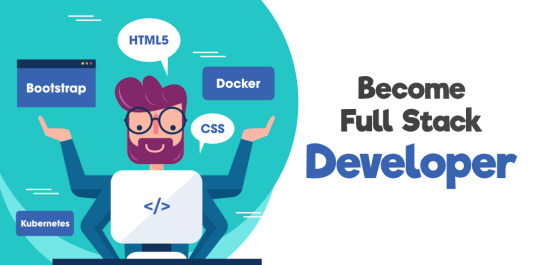
In the ever-evolving realm of technology, the role of a full-stack developer has undeniably gained prominence. Full-stack developers epitomize versatility and are an indispensable asset to any enterprise or endeavor. They wield a comprehensive array of competencies that empower them to navigate the intricate landscape of both front-end and back-end web development. In this exhaustive compendium, we shall delve into the intricacies of transforming into a proficient full-stack developer, dissecting the requisite skills, indispensable tools, and strategies for excellence in this domain.
Deciphering the Full Stack Developer Persona
A full-stack developer stands as a connoisseur of both front-end and back-end web development. Their mastery extends across the entire spectrum of web development, rendering them highly coveted entities within the tech sector. The front end of a website is the facet accessible to users, while the back end operates stealthily behind the scenes, handling the intricacies of databases and server management. You can learn it from Uncodemy which is the Best Full stack Developer Institute in Delhi.
The Requisite Competencies
To embark on a successful journey as a full-stack developer, one must amass a diverse skill set. These proficiencies can be broadly categorized into front-end and back-end development, coupled with other quintessential talents:
Front-End Development
Markup Linguistics and Style Sheets: Cultivating an in-depth grasp of markup linguistics and style sheets like HTML and CSS is fundamental to crafting visually captivating and responsive user interfaces.
JavaScript Mastery: JavaScript constitutes the linchpin of front-end development. Proficiency in this language is the linchpin for crafting dynamic web applications.
Frameworks and Libraries: Familiarization with popular front-end frameworks and libraries such as React, Angular, and Vue.js is indispensable as they streamline the development process and elevate the user experience.
Back-End Development
Server-Side Linguistics: Proficiency in server-side languages like Node.js, Python, Ruby, or Java is imperative as these languages fuel the back-end functionalities of websites.
Database Dexterity: Acquiring proficiency in the manipulation of databases, including SQL and NoSQL variants like MySQL, PostgreSQL, and MongoDB, is paramount.
API Expertise: Comprehending the creation and consumption of APIs is essential, serving as the conduit for data interchange between the front-end and back-end facets.
Supplementary Competencies
Version Control Proficiency: Mastery in version control systems such as Git assumes monumental significance for collaborative code management.
Embracing DevOps: Familiarity with DevOps practices is instrumental in automating and streamlining the development and deployment processes.
Problem-Solving Prowess: Full-stack developers necessitate robust problem-solving acumen to diagnose issues and optimize code for enhanced efficiency.
The Instruments of the Craft
Full-stack developers wield an arsenal of tools and technologies to conceive, validate, and deploy web applications. The following are indispensable tools that merit assimilation:
Integrated Development Environments (IDEs)
Visual Studio Code: This open-source code editor, hailed for its customizability, enjoys widespread adoption within the development fraternity.
Sublime Text: A lightweight and efficient code editor replete with an extensive repository of extensions.
Version Control
Git: As the preeminent version control system, Git is indispensable for tracking code modifications and facilitating collaborative efforts.
GitHub: A web-based platform dedicated to hosting Git repositories and fostering collaboration among developers.
Front-End Frameworks
React A potent JavaScript library for crafting user interfaces with finesse.
Angular: A comprehensive front-end framework catering to the construction of dynamic web applications.
Back-End Technologies
Node.js: A favored server-side runtime that facilitates the development of scalable, high-performance applications.
Express.js: A web application framework tailor-made for Node.js, simplifying back-end development endeavors.
Databases
MongoDB: A NoSQL database perfectly suited for managing copious amounts of unstructured data.
PostgreSQL: A potent open-source relational database management system.
Elevating Your Proficiency as a Full-Stack Developer
True excellence as a full-stack developer transcends mere technical acumen. Here are some strategies to help you distinguish yourself in this competitive sphere:
Continual Learning: Given the rapid evolution of technology, it's imperative to remain abreast of the latest trends and tools.
Embark on Personal Projects: Forge your path by creating bespoke web applications to showcase your skills and amass a portfolio.
Collaboration and Networking: Participation in developer communities, attendance at conferences, and collaborative ventures with fellow professionals are key to growth.
A Problem-Solving Mindset: Cultivate a robust ability to navigate complex challenges and optimize code for enhanced efficiency.
Embracing Soft Skills: Effective communication, collaborative teamwork, and adaptability are indispensable in a professional milieu.
In Closing
Becoming a full-stack developer is a gratifying odyssey that demands unwavering dedication and a resolute commitment to perpetual learning. Armed with the right skill set, tools, and mindset, one can truly shine in this dynamic domain. Full-stack developers are in high demand, and as you embark on this voyage, you'll discover a plethora of opportunities beckoning you.
So, if you aspire to join the echelons of full-stack developers and etch your name in the annals of the tech world, commence your journey by honing your skills and laying a robust foundation in both front-end and back-end development. Your odyssey to becoming an adept full-stack developer commences now.
5 notes
·
View notes
Text
ok here's yet another way you could nerf logistics bots:
each roboport network can only handle a certain number of distinct item types being transported at a time. this only affects items being transported to chests. entity prototypes can be given a flag that makes deliveries to them separate from this limit - by default this would apply to players, spidertrons, and rocket silos in the expansion. this limit also never applies to construction robots.
to raise this limit you can build special computers. however, these have to take up space within the logistic zone of roboports, and their effect is divided by the number of roboports in the network, and they're also expensive as hell. so you're incentivized to build compact, dedicated-purpose roboport networks and route stuff by belt where it makes sense. there would also be a "network bridger" building which would merge nearby roboport networks for the purposes of construction bots and player/spider/rocket resupply while keeping them isolated for requester chest purposes, it would just need logistic bots to remember which network they originated from and go back there to prevent networks being entirely drained of bots over time.
as a compensation for this restriction you would get requester chests as soon as you unlock logistic robots, and the computer and bridger would unlock with yellow science.
maybe you could have the ability for network bridgers to merge networks for chest-requests, but only for a specific item type. so you can have a roboport net covering your railroads, useful for building more railroads, and then specialized networks at each village/outpost/cityblock/whatever, and then the bridgers are configured to let your robots bring in rocket/nuclear fuel for your trains to any part of the base. while in flight they would be counting against the item diversity limit of every network they needed to go through, but since the biggest network is only moving one item type, you don't need any of the expensive computers there where you would need hundreds or thousands of them. and if any of your specialist local networks were at the limit they would need only one or a few computers to allow fuel delivery.
for bot use in malls, you would still want to deliver ingredients like green circuits that lots of things need in huge quantities by belt. but specialty intermediates needed in low quantities would be bot-deliverable. you pretty rarely would need a bot carrying engine units to actually be in the air, so those would only sometimes count against the limit.
you *could* still deliver green circuits to things like rail signals where they are kind of a specialty ingredient and you don't literally always need to be crafting them, but delivering *bulk* green circuits to solar panels and laser turrets would still be desirable because less bot traffic means less recharge need means fewer roboports beyond the minimum needed to cover the space means fewer computers per limit increase.
this probably makes more sense in packs with way more intermediate diversity though. so it would probably not ever be implemented by wube. and it would not be doable with the modding api.
2 notes
·
View notes